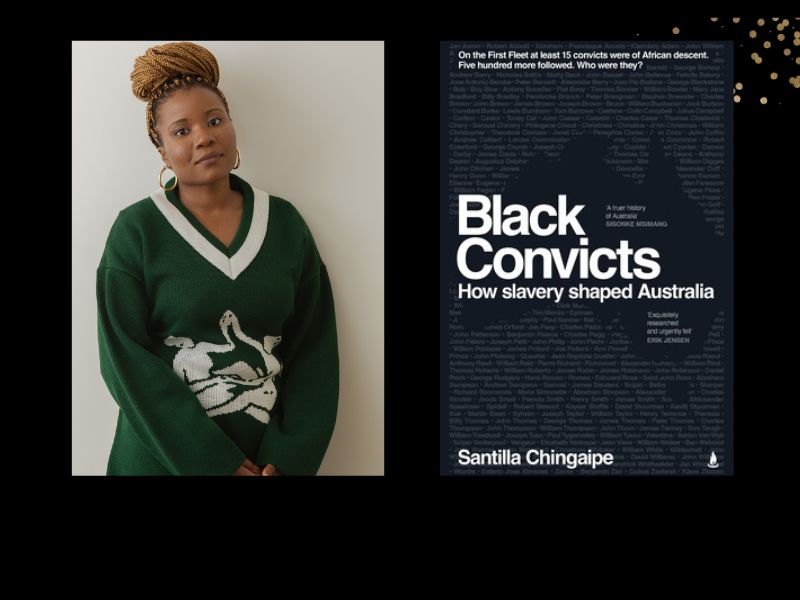In Black Convicts, Santilla Chingaipe embarks on a six-year journey that culminates in a vital historical record, shedding light on the often overlooked narratives of Black convicts in Australia. This book is not just a recounting of history – it is an urgent call to acknowledge and confront the complexities of Australia’s past, one that challenges the traditional white, middle-aged male narratives that have dominated historical discourse. As the African proverb suggests, “Until the lion tells the story, the hunter will always be the hero,” Chingaipe’s work seeks to give voice to the lions of history, offering insights that are both enlightening and essential.
The book adopts a multifaceted approach, combining academic rigour with auto-ethnographic elements and archival research. The narrative is an evocative tapestry that weaves together personal experiences, rigorous scholarship and a deep commitment to unearthing the truths buried within colonial archives. Chingaipe’s storytelling style invites readers into an intricate dialogue about the past, showcasing her remarkable ability to blend personal reflection with archival inquiry.
The author’s background as an award-winning journalist is evident throughout Black Convicts. With global recognition from esteemed platforms like The New York Times, The Guardian, the BBC and SBS, Chingaipe has established herself not only as a storyteller, but also as a historian dedicated to unravelling the complexities of Australia’s colonial history. Although she never initially envisioned herself in this role, Black Convicts cements her position as a formidable voice in historical discourse.
Chingaipe’s exploration of Australian history reveals its dark layers, where the realities of colonisation and the exploitation of Black bodies are often sanitised or ignored. She poignantly notes that history is frequently shaped by those with power, leaving marginalised voices unheard. Her journey into this subject matter began serendipitously at an art exhibition at the National Gallery of Victoria (NGV), prompting her to delve deeply into the archives and uncover the silenced stories of Black convicts. The urgency of her findings extends beyond Australia; it connects with global histories of oppression and resistance, emphasising that the legacies of colonialism are intertwined across continents.
In the book’s opening chapter, Chingaipe deconstructs the dominant narrative that Captain Cook ‘discovered’ Australia, revealing the contradictions embedded in this myth. She sheds light on the historical realities of slavery and forced labour, particularly regarding “commodities, desirable in Europe [like] cotton, tobacco, gold and silver”, which were produced at the expense of Black lives. This counter-narrative not only challenges the whitewashed version of history, but also calls for an urgent reconsideration of how we understand our past.
Chingaipe’s meticulous research is evident in her analysis of the complexities of racial dynamics within the convict system. She presents the stories of individuals like Julius Campbell, illustrating the diverse experiences of Black convicts and the dangers of homogenising their narratives. Through her journalistic lens, she captures the lived realities of these individuals, highlighting their resilience in the face of systemic oppression.
The author’s tone is both gentle and respectful, inviting readers to engage with difficult histories while acknowledging the emotional weight they carry. Chingaipe’s commitment to presenting a balanced view is commendable; she confronts uncomfortable truths about the harsh realities faced by Black convicts and the oppressive colonial power structures without shying away from their complexities.
Yet, this process is not without its challenges. Throughout her research, Chingaipe grapples with discomfort, striving to present a digestible account of countless heart-wrenching historical facts. As she candidly states, “The research involved in putting this book together has meant that I have had to read some harrowing testimony. Of all the documents I have examined, Thomas Burrows’ statement to the police, and the testimony from the colonial inquest, were the hardest for me to stomach.” This duality between the need for authenticity and the emotional toll of confronting such painful histories defines her work and showcases her dedication to telling these stories while navigating her own discomfort in doing so.
Throughout the 14 chapters of Black Convicts, Chingaipe employs a narrative style that intertwines personal anecdotes with historical analysis. Each chapter opens with a powerful statement that anchors the stories of Black convicts within the broader context of colonial Australia. By doing so, she not only reclaims their narratives, but also highlights the interconnectedness of history as a living entity that continues to shape our present.
Black Convicts is a significant work that serves as both a historical account and a poignant reminder of the ongoing struggles for recognition and justice. Chingaipe’s compelling exploration of the roles played by Black convicts in Australia challenges us to reconsider our understanding of history and its impact on contemporary society. This book is not solely a recounting of the past; it is a clarion call for a more inclusive and honest engagement with history, one that acknowledges the contributions and sacrifices of those who have been historically marginalised.
Read: Book review: Saltwater Cure: True stories of the transformative power of the ocean, Ali Gripper
Chingaipe has not only illuminated a critical aspect of Australian history, but has also paved the way for future discourse on race, identity and belonging.
Black Convicts: How Slavery Shaped Australia, Santilla Chingaipe
Publisher: Simon & Schuster
ISBN: 9781761107238
Format: Paperback
Pages: 320pp
Publication: 30 October 2024
RRP: $34.99





